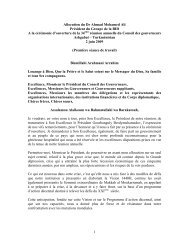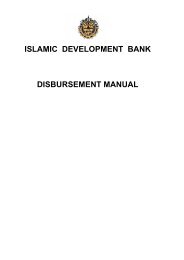Mauritania - Islamic Development Bank
Mauritania - Islamic Development Bank
Mauritania - Islamic Development Bank
Create successful ePaper yourself
Turn your PDF publications into a flip-book with our unique Google optimized e-Paper software.
strategy giving priority to strengthening<br />
primary care provision especially in rural areas.<br />
• Substantially raising allocation in the budget<br />
for health system interventions with increased<br />
resources devoted to disease prevention<br />
and control program and the training of<br />
primary health staff (nurses, midwifes and<br />
general practitioners) and community health<br />
promoters.<br />
• Increase the deployment and retention of<br />
the trained health staff for remote and needy<br />
areas to augment the efforts of partners to<br />
expedite interventions addressing the high<br />
IMR and MMR.<br />
3. PILLAR II: Rural <strong>Development</strong> and Food<br />
Security<br />
3.1 Current Status<br />
71. Agriculture has not been performing well<br />
in <strong>Mauritania</strong>. On average, the contribution of<br />
agriculture to GDP was 16.7% during the 1991-<br />
2008 period with crops (agriculture sensu stricto)<br />
representing 3.7% and livestock 13%. In absolute<br />
terms, agriculture production has not been<br />
declining but stagnating. Stagnation had many<br />
causes. In rain fed areas where rainfall is low and<br />
erratic, water harvesting and soil conservation<br />
techniques to improve production exist but not<br />
adopted on a large scale. There has been little or<br />
inadequate effort to support rain fed agriculture<br />
and livestock despite its importance in rural<br />
economy.<br />
72. Food security is a major concern. Cereal<br />
production in <strong>Mauritania</strong> supplies only one<br />
third of the population’s needs. Commercial<br />
imports and food aid (mainly wheat and rice)<br />
supply the balance. In recent years, the level of<br />
food supply has been low, particularly in remote<br />
areas, and prices of traditional cereals (millet and<br />
sorghum in particular) in the production areas<br />
have increased especially in the wake of 2008<br />
global food crisis. Adverse climatic conditions<br />
also caused a decrease in crop production adding<br />
to food insecurity affecting almost one third of<br />
the total population, particularly the rural poor.<br />
Malnutrition in rural areas is rampant and the<br />
most susceptible group includes infants, and<br />
pregnant women. The Government has acted to<br />
in coordination with its development partners<br />
to deal with food crises. However, the second<br />
Strategic Framework for the Fight against Poverty<br />
(PRSP II) for 2006-2010 and various instruments<br />
of the Special Intervention Program created to<br />
address food insecurity had limited impact and<br />
food production continued to stagnate.<br />
3.2. Constraints<br />
73. There are several constraints faced by<br />
agriculture in <strong>Mauritania</strong>:<br />
• Annual area under cultivation did not increase<br />
and yields remain low by international<br />
standards.<br />
• In rain fed areas where rainfall is low and<br />
erratic, water harvesting and soil conservation<br />
techniques to improve production exist but not<br />
adopted on a large scale. There has been little<br />
or inadequate support for rain fed agriculture<br />
and livestock despite its importance in rural<br />
economy.<br />
• In irrigated areas, agriculture is performing<br />
poorly despite the significant investments<br />
made over the past 30 years. This is due to<br />
a combination of factors--natural disasters<br />
(floods, locust, etc.), institutional failures<br />
(mismanagement, credit and land tenure<br />
issues), and a weak investment climate<br />
(inadequate infrastructure, volatility in<br />
international prices of cereals, overvaluation<br />
of the exchange rate). Local officials in<br />
Rosso informed the MCPS mission that<br />
abandonment of irrigated land by farmers is a<br />
serious problem and farmers that met with the<br />
mission indicated that Government subsidies<br />
were essential for them to survive. This has all<br />
contributed to the inability of increases in the<br />
size of irrigated areas under new schemes to<br />
compensate for areas put out of cultivation. In<br />
2009, only 8,000ha were cultivated compared<br />
to an average of 17.000 ha planted annually in<br />
last ten years.<br />
• With its important livestock population (11<br />
million of sheep, goats, cattle and camels),<br />
<strong>Mauritania</strong> is self sufficient in red meat and<br />
exports a substantial volume (estimated at<br />
MCPS for <strong>Mauritania</strong>, 2011-2015 19






